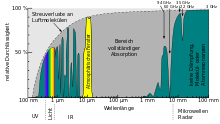Atmospheric window
In meteorology and remote sensing, an atmospheric window is a wavelength interval of the electromagnetic radiation spectrum (e.g. visible light ) for which the earth's atmosphere is largely permeable ( transparent ).
The gas mixture in the atmosphere, the air, contains various gases ( ozone , carbon dioxide , water vapor , etc.) that absorb or scatter electromagnetic radiation depending on their wavelength . This has an impact on the energy balance and consequently the temperatures on earth, by shielding dangerous doses of radiation for life on earth and on the observability of sources of electromagnetic waves outside the atmosphere.
Energy balance and greenhouse effect
The sun passes through its light of all emitted wavelengths of the Earth a large heat output. The earth in turn emits electromagnetic waves of longer wavelengths as a black body. Only part of the earth's thermal radiation in the IR range can penetrate the outside, the rest is scattered back. Due to this greenhouse effect , the average temperature on the earth's surface is higher than without an atmosphere, the temperature difference depends on the density and composition of the atmosphere. The most important wavelength range is shown in yellow in the adjacent picture, because the earth, which is around 300 K, radiates particularly strongly here.
Absorption of UV radiation in the ozone layer
The ozone of the stratospheric ozone layer absorbs the short-wave UV radiation in the wavelength range below 300 nanometers practically completely, so that this high-energy UV radiation cannot penetrate the earth's surface. This is of great importance for life on earth, as the so-called hard UV radiation has a carcinogenic and mutagenic effect on organisms. Too high a cancer rate is immediately fatal for the survival of higher animal species; too high a mutation rate endangers all forms of life. In order to avoid these risks, the Australians particularly affected by the thinning of the ozone layer (see also: ozone hole ) do not expose their skin to direct sunlight. Since the ozone completely absorbs the UV radiation between approx. 200 and 300 nanometers, this wavelength interval does not represent an atmospheric window, but an absorption band , the counterpart to the atmospheric window.
Atmospheric windows
Wavelength intervals that are barely or not at all absorbed and scattered by the atmospheric gases are known as atmospheric windows.
Optical window
The atmosphere is almost transparent to the range of visible light as well as near infrared radiation. This enables solar radiation of this wavelength range to reach the earth's surface in large quantities. These wavelengths are emitted particularly intensely by the 5800 K sun. Without this atmospheric window, no photosynthesis- based life - as we know it - would be possible on earth, since no light would reach the earth's surface if the radiation were strongly absorbed and scattered by the molecules of the atmospheric gases in this wavelength interval.
Further atmospheric windows that are less important for photosynthesis are in the approximate wavelength ranges from 750 to 850 nanometers, from 950 to 1100 nanometers, from 1200 to 1300 nanometers, from 1500 to 1700 nanometers and from 2100 to 2400 nanometers.
Astronomical window
The optical window allows the observing astronomy to observe astronomical objects in the range of visible light and in the near infrared, the radio window allows the observation of astronomical objects with methods of radio astronomy from the ground. The latter includes frequencies from 15 MHz up to the order of 100 GHz, which corresponds to wavelengths from 20 m down to a few millimeters.
Web links
- Remote Sensing: Absorption Bands and Atmospheric Windows. In: Earth Observatory. NASA, accessed June 12, 2012 .
- IR Atmospheric Windows. In: Cool Cosmos. Infrared Processing and Analysis Center & the SIRTF Science Center (NASA), accessed June 14, 2016 .
Individual evidence
- ↑ GW Paltridge, CMR Platt: Radiative Processes in Meteorology and Climatology. Elsevier, Amsterdam / Oxford / New York 1976, ISBN 0-444-41444-4 , pp. 139-140, 144-147, 161-164.
- ↑ RM Goody, YL Yung: Atmospheric Radiation. Theoretical basis. 2nd Edition. Oxford University Press, New York 1989, ISBN 0-19-505134-3 , pp. 201-204.
- ^ KN Liou: An Introduction to Atmospheric Radiation. 2nd Edition. Academic Press, Elsevier, Amsterdam 2002, ISBN 0-12-451451-0 , p. 119.
- ^ R. Stull: Meteorology, for Scientists and Engineers. Brooks / Cole, Delmont CA, 2000, ISBN 0-534-37214-7 , p. 402.
- ^ JT Houghton: The Physics of Atmospheres. 3. Edition. Cambridge University Press, Cambridge UK, 2002, ISBN 0-521-80456-6 , pp. 50, 208.


